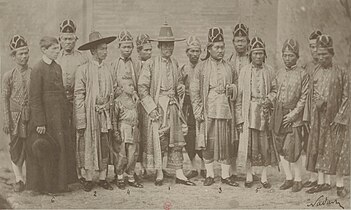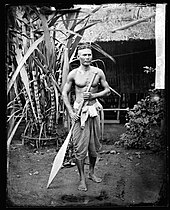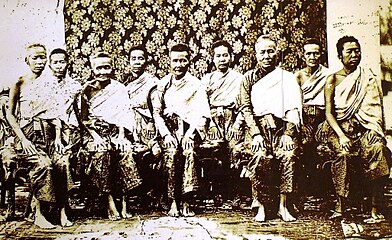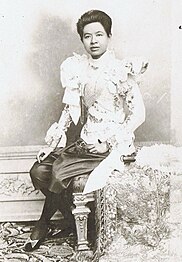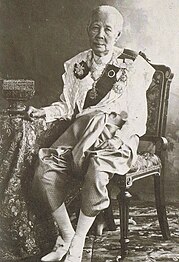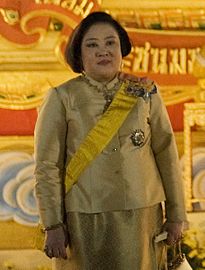History of Thai clothing
This article needs additional citations for verification. (July 2012) |
Thai traditional costumes vary by city and the ruler of each historical period.
Sukhothai
Sukhothai clothing style became the fashion in 13-15th century. During the period The city-state of Sukhothai was united other Tai city-states into one kingdom. Sukhothai Men's clothing was a simple full sleeved top with a long V shape neck and a cloth brace on their shoulders. The loincloth was made of silk with a big metal or golden belt. Women's clothing was a long silk sarong with flowers painted on it. The top normally is a full sleeved silk cloth. Married women wore one cloth wrapped around the breasts made of silk or other fabric.[2]
Ayutthaya
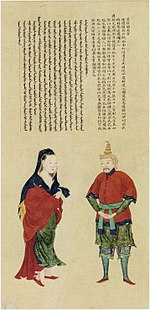
Ayutthaya clothing was the style during the 14-18th centuries. Ayutthaya city was the capital of Thai kingdom for 417 years, the longest period of Thailand that was ruled under one monarch.[3] Many styles clothing followed the period of Ayutthaya but the fashion changed frequently under the influence from various countries who come into contact and trading with the kingdom.
Historically, both Thai males and females dressed themselves with a loincloth wrap called
-
Thai traditional costumes in Bangkok National Museum
-
Siam delegates inPeking in 1761 from the Ten Thousand Nations Coming to Pay Tributemonumental painting
-
Ok-khun Chamnan, a 17th-century Siamese ambassador who visited France and Rome on an embassy in 1688
-
Kosa Pan wearing lomphok and Khrui, 1686
-
Claude de Forbin wearing Ayutthayan mandarin dress
-
The French ambassadorKing Narai, 1685
-
A Siamese official wearingSimon de La Loubère
-
Portrait of Siamese aristocrats from The Portraits of Periodical Offering of Imperial Qing by Xie Sui
Thonburi
This section is empty. You can help by adding to it. (October 2017) |
Rattanakosin
Early Rattanakosin
Early Rattanakosin central Thais dressed as same as Ayutthaya period, however, after the
- Men's clothing
-
Binnya Sein or Chaophraya Mahayotha, the commander of Mon regiment during the reign of King Rama I in the 1800s
-
PrinceKing Mongkut(Rama IV) wearing the royal costumes of the early Rattanakosin period
-
Prince Nakkhatra Mangala, was the eldest son of Prince Kitiyakara Voralaksana wearing the royal costumes of the early Rattanakosin period
-
Photograph of theSiamese embassy to Francein 1861, wearing the formal clothing of the early Rattanakosin period
-
Prince Ammarit, the son of King Nangklao (Rama III), before 1870
-
Sri Suriyawongse was a Prime Minister of Southern Siam during the reign of King Chulalongkorn(Rama V), 1865
-
Prince Yodyingyot, later Bowon Wichaichan with the early Rattanakosin style clothing, before 1885
-
Young Prince Chulalongkorn (Rama V) and his two younger brother in 1851
-
Photograph of a 19th century Siamese boatman by John Thomson
-
Thai men squat with the early Rattanakosin style clothing
- Women's clothing
-
Siamese girl with the early Rattanakosin style clothing, 1921
-
Princess Kinnari, the 30th daughter ofKing Rama III, 1819
-
Queen Sunandha, one of the four consorts of King Chulalongkorn with the early Rattanakosin style clothing
-
Tieng Rojanadis, was a consort of King Mongkut (Rama IV)
-
Siamese peasant, 1904
-
Queen Debsirindra, the second consort of King Mongkut with the early Rattanakosin style clothing, 1855
-
Daughters ofKing Rama III
-
Lady Pun Bunnag, Somdet Chaophraya Borom Maha Sri Suriwongse's wife with the early Rattanakosin style clothing in 1866
-
Princess Ying Yaowalak Akkharatchasuda (1851–1886), was the daughter of King Mongkut
-
Daughters of King Mongkut (Rama IV) with the early Rattanakosin style clothing
-
A traditional Siamese female quartet with the early Rattanakosin style clothing
-
Queen Savang Vadhana, a consort of King Chulalongkorn (Rama V) in 1879
-
Princess Nariratana, was the daughter of King Mongkut (Rama IV)
-
QueenKing Mongkut(Rama IV)
-
Princess Thip Keson (or Thep Kraison), Princess of Chiang Mai, consort of Inthawichayanon of Chiang Mai and mother of Dara Rasmi, before 1884
-
Princesspha biang at Dusit Palace, 1909
-
Princess Lamom, was the daughter of King Nangklao (Rama III), before 1896
-
Siamese womens photo, 1890
-
Painting of Siamese womans wearingpha biang in Wat Pho, Bangkok
Modern Rattanakosin
From the 1860s onward, Thai royals "selectively adopted Victorian corporeal and sartorial etiquette to fashion modern personas that were publicized domestically and internationally by means of mechanically reproduced images."[6] Stitched clothing, including court attire and ceremonial uniforms, were invented during the reign of King Chulalongkorn.[6] Western forms of dress became popular among urbanites in Bangkok during this time period.[6]
During the early 1900s, King
- Noblemen's clothing
-
Kingchong kraben
-
Prince Damrong Rajanubhab wearing the raj pattern costume, 1900
-
King Vajiravudh wearing the raj pattern covered with the khrui
-
Prince Vividhavannapreecha, the 51st son of King Chulalongkorn in 1893
-
Portrait of Mom Luang Pin Malakul as a student at Suankularb Wittayalai School, 1910s
- Noblewomen's clothing
-
Queen consort Sukhumala Marasri of King Chulalongkorn (Rama V). with her mother and daughters in 1880
-
Queen consort Sukhumala Marasri and the princesses of King Chulalongkorn (Rama V), 1887
-
Queen Saovabha Phongsri, an agnatic half-sister and queen of King Chulalongkorn (Rama V), 1897
-
Chum Krairoek Royal Highness Consort of King Chulalongkorn (Rama V) and her daughters in 1900s
-
Princess Puangsoi Sa-ang, was the daughter of King Mongkut (Rama IV), 1880
-
Princess Suddha Dibyaratana or the Princess of Rattanakosin, was the daughter of King Chulalongkorn (Rama V), before 1910
-
Princess Saisavali Bhiromya, was a princess consort of King Chulalongkorn (Rama V), 1887
-
Chao Chom Mom Rajawongse Sadap (1890–1983), was the noble consort of King Chulalongkorn (Rama V)
-
Princes Mankhian, was the daughter ofKing Rama II
-
Thai princess of the Inner Court of the Grand Palace, Bangkok in 1890
-
Daughters ofKing Rama V, 1904
-
Prince Dilok Noppharat and his mother, Princess Thip Keson of Chiang Mai in 1896
-
Prince Yugala Dighambara and his mother, Princess Saisavali Bhiromya a consort of King Chulalongkorn (Rama V), before 1905
-
Prince Mahidol Adulyadej with his sister Princess Valaya Alongkorn and his mother, Queen Sri Savarindira (Savang Vadhana), 1925
Fascist Thailand
On 15 January 1941,
Contemporary Thai clothing
The formal Thai costume, known in
- Women's clothing
-
PrincessSoamsavali wearing the "Chut Thai Amarin" (Thai: ชุดไทยอัมรินทร์
-
PrincessUbolratana wearing the "Chut Thai Boromphiman" (Thai: ชุดไทยบรมพิมาน)
- Men's clothing
-
Prem Tinsulanonda, former Thai Prime Minister wearing the "chut thai phra ratcha niyom" (Thai: ชุดไทยพระราชนิยม)
-
Former Thai Prime Minister Abhisit Vejjajiva wearing the "chut thai phra ratcha niyom" (Thai: ชุดไทยพระราชนิยม)
-
Surayud Chulanont, former Thai Prime Minister wearing the "chut thai phra ratcha niyom" (Thai: ชุดไทยพระราชนิยม)
See also
References
- ^ Silahorm, kanokporn, kanhittha et al (2007),Thai Costume(In thai).
- ^ Chayada (2009),thaigoodview.com(In thai)
- ^ Thailand Knowledge Center (March 2012),The costume of Ayutthaya(In thai)
- ^ .
- ^ Jotisalikorn, Chami (2013). Thailand's Luxury Spas: Pampering Yourself in Paradise. Tuttle Publishing. p. 183.
- ^ ISBN 9781845193997.
- ^ Sarutta (10 September 2002). "Women's Status in Thai Society". Thaiways Magazine. Archived from the original on 31 October 2016. Retrieved 7 November 2016.
- ^ The Royal Gazette, Vol. 58, Page 113. January 21, B.E. 2484 (C.E. 1941). Retrieved on June 4, 2010.
External links
- "การแต่งกายของไทย". Postjung.com. Archived from the original on 2014-04-27. Retrieved 2012-07-21.
- "ถ่ายภาพชุดไทย ภาพโบราณ แต่งชุดไทย ถ่ายภาพ ล้านนา ทวารวดี อยุธยา รัตนโกสินทร์". Bangkokstudiothai.com. Archived from the original on 2012-08-05. Retrieved 2012-07-21.
- teenee.com. "การแต่งกายของสตรีไทยตามประวัติศาสตร์โบราณคดีจนถึงปัจจุบัน : อาหารสมอง". Variety.teenee.com. Retrieved 2012-07-21.
- "การแต่งกายสมัยอยุธยา (พ.ศ. 1893 ถึง พ.ศ. 2310)". Baanjomyut.com. Retrieved 2012-07-21.
- การแต่งกายสมัยอยุธยา














